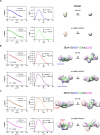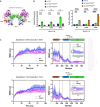Histone modification-driven structural remodeling unleashes DNMT3B in DNA methylation
- PMID: 40138405
- PMCID: PMC11939060
- DOI: 10.1126/sciadv.adu8116
Histone modification-driven structural remodeling unleashes DNMT3B in DNA methylation
Abstract
The DNA methyltransferase 3B (DNMT3B) plays a vital role in shaping DNA methylation patterns during mammalian development. DNMT3B is intricately regulated by histone H3 modifications, yet the dynamic interplay between DNMT3B and histone modifications remains enigmatic. Here, we demonstrate that the PWWP (proline-tryptophan-tryptophan-proline) domain within DNMT3B exhibits remarkable dynamics that enhances the enzyme's methyltransferase activity upon interactions with a modified histone H3 peptide (H3K4me0K36me3). In the presence of H3K4me0K36me3, both the PWWP and ADD (ATRX-DNMT3-DNMT3L) domains transition from autoinhibitory to active conformations. In this active state, the PWWP domain most often aligns closely with the catalytic domain, allowing for simultaneous interactions with H3 and DNA to stimulate DNA methylation. The prostate cancer-associated DNMT3B R545C mutant is even more dynamic and susceptible to adopting the active conformation, resulting in aberrant DNA hypermethylation. Our study suggests the mechanism by which conformational rearrangements in DNMT3B are triggered by histone modifications, ultimately unleashing its activity in DNA methylation.
Figures







References
MeSH terms
Substances
LinkOut - more resources
Full Text Sources
Research Materials
Miscellaneous

